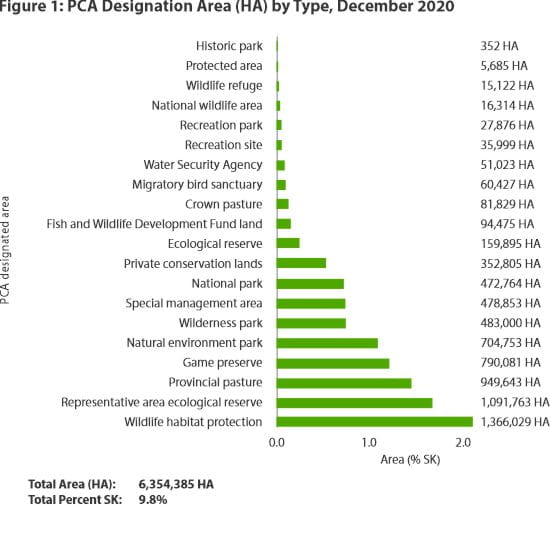There are many designated area types in Saskatchewan. As shown on Figure 1, and 2, approximately 6.4 million hectares or 9.8 per cent of the 12 per cent target has been protected and conserved. The 9.8 per cent has been achieved by preserving ecological resources, maintaining the integrity of biologically diverse areas, protecting wildlife habitats, preserving areas of high scenic value and unique physical features (e.g. waterfalls, badlands and sand dunes), and providing recreational, educational and research opportunities. An overarching goal is to recognize areas within each of Saskatchewan's 11 ecoregions. Most lands within the PCAN are Crown lands designated under some form of legislated protection or management agreement. The network also includes private lands conserved through conservation easements held by conservation partners or managed under private stewardship agreements.

PCAN is specifically and uniquely designed to meet Saskatchewan’s needs, ensuring a balanced approach to land protection and conservation while supporting biodiversity and economic development. By incorporating each ecoregion into the network, PCAN strives to create a comprehensive and representative system of
protected areas. The program employs a range of tools and strategies and actively collaborates with all stakeholders, and partners to explore diverse opportunities that align with both PCAN’s conservation goals and overall government priorities. For more details on the areas included in PCAN, please see Figure 2.

The Government of Saskatchewan considers both traditional protected areas and Other Effective Area-Based Conservation Measures (OECMs) in its approach to land conservation. While typical protected areas are designated to safeguard biodiversity and ecosystems by restricting activities that may impact conservation values, OECMs offer an alternative that achieves similar conservation outcomes. These measures allow for the sustainable use of natural resources while ensuring the long-term conservation of biodiversity and cultural values. This balanced approach enables the province to effectively protect critical habitats and landscapes while supporting economic and cultural needs.

